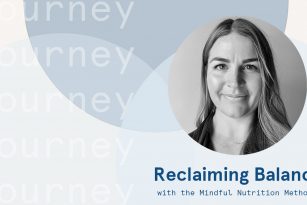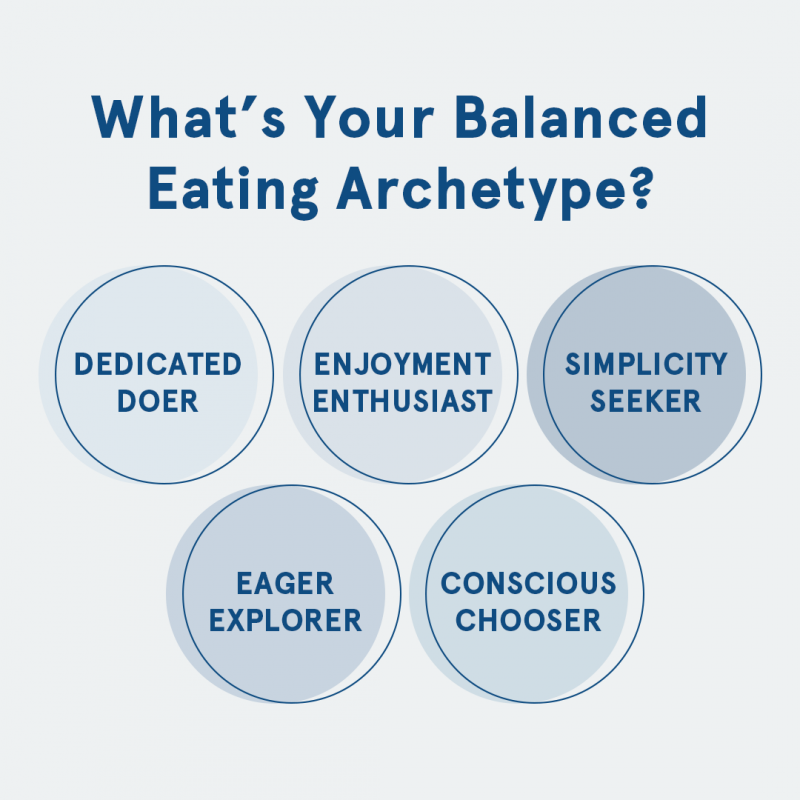Learn why resetting your body isn’t the key to your success, and what to do instead.
Have you ever eaten something you thought was “bad”, then immediately thought to yourself, “How can I reset my body and make up for eating badly?”? This is one of the most common phrases I hear as a Registered Dietitian.
Unfortunately, resetting or doing things to “make up for” what you ate isn’t recommended, healthy, or going to give you the results you’re hoping for. But, if you’ve had this thought or taken actions to “undo” eating foods you thought were “bad”, it’s completely understandable why you thought that was what you should do.
So much of the messaging around food and nutrition is about being perfect all of the time, and if you’re not, you need to do a detox, reset, cleanse, go twice as hard at the gym or eat less, and the list goes on.
Now, you may be wondering, why is resetting not the best way to handle the situation, and what should I be doing instead? Keep reading and we’ll dive into it!
The Cause Of Wanting To “Reset” Your Body
The concept of “resetting” and “making up” for eating bad foods stems from a concept called food morality, which is the labeling of foods as either “good” or “bad”, “right” or “wrong”.
In the context of dieting, “good food” is often characterized by foods that are nutrient-dense. They may also be called “clean”, “correct”, “right”, or “perfect”. It’s typically defined by those that are associated with positive health outcomes when consumed regularly. Think of lean proteins, fiber-rich starchy carbohydrates, fruit, non-starchy carbohydrates, and health-supportive fats.
On the other hand, “bad food” is usually used to describe those items that have little to no nutritional value, or those that may be associated with negative health outcomes when consumed regularly. People will typically label them as “off-limits”, “wrong”, or “not good”. Typically we think of “bad foods” as being those items like traditional pizza, ice cream, candy, hot dogs, chips, or others of that sort.
So what’s wrong with assigning morality to food?
The problem with the concept of food morality is that it can start to snowball and complicate your relationship with food.
When we assign “good” and “bad” labels to food, food starts to become black and white, right and wrong, and the food we eat (or don’t eat) starts to dictate how we feel.
For example, if we make “good” choices, we may feel prideful and confident. Yet when we make “bad” choices, we may feel shameful and guilty. This naturally leads us to try to avoid or restrict food items that are in the “bad” category.
But because we are human, we often can’t do that — and for good reason, too! Oftentimes the food items in the “bad” category are really enjoyable and are food items we truly want to have deep down, which is absolutely okay and mindful to do!
These food rules and harsh lines of right and wrong leave us constantly feeling at war with ourselves. We tell ourselves we shouldn’t eat the “bad” foods, but we know we really want them, so eventually, we have them. That finally leads us to want to “reset” and make up for eating “bad” foods in the first place.
Additionally, these thoughts and behaviors can often become disordered, leading to an unhealthy relationship with food and your body. Ultimately, harming your physical, mental, and emotional health.
Why Resetting Your Body Isn’t Helpful (Plus, How It Can Hurt Your Health and Long-term Goals)
Now is the time where you may be saying to yourself, “Well, Erica, certain foods aren’t “good” for me and I shouldn’t have them, so what’s wrong with feeling remorseful about having them and “resetting” in response?”.
As harmless as this mindset may sound, it actually causes so much damage and harm in the long run. It leads to an imbalanced, unhealthy relationship with food. One where we’re either dieting and following strict food rules or mindlessly overindulging to the point of discomfort. All of this leads to food guilt, stress, and overwhelm.
This is where we can get into a bit of trouble, and where the imbalanced nature of the all-or-nothing cycle gets started.
The Nutrition Stripped Balance Spectrum
The Balance Spectrum is a tool we use here at Nutrition Stripped to describe the balanced eating cycle. As a Registered Dietitian and Mindful Nutrition Method Coach, I find this tool to be so helpful for so many of my clients. So let’s walk through it together so it can help you, too!
Picture a big line with a tick-mark in the middle of it. On one half of this Balance Spectrum line, we have enjoyment, and on the other half, we have nourishment. Somewhere in the middle where that tick-mark is, and slightly to the right and left of it, the two come together. This is where we find balance. Yet on either polarizing, far ends of the spectrum, we have the “all-in” and “all-out” ends of the spectrum that we want to try to avoid.
If you’re not familiar with our Balance Spectrum tool, you can download our free guide that walks you through it in even more detail!
How Resetting Causes The All Or Nothing Cycle
When we try to make up for “bad” eating by “resetting”, we end up doing something we call “pendulum swinging” on the Balance Spectrum. We quickly move from the enjoyment half of the Balance Spectrum, all the way over to the “all-in” end of nourishment.
The “all-in” end may look like a further restriction of “bad” foods, calorie counting, macro counting, strict food rules, and eating schedules. All in an attempt to “make up for” eating “bad foods”.
But what do you think happens when we spend too much time on the “all-in” end of the spectrum? You guessed it, we swing right back over to the “all-out”, polarising end of the spectrum. It’s not a graceful, easeful slide to a bit more enjoyment, it’s a full-on swing to enjoyment only, instant gratification only.
Picture a pendulum here. If we pull too hard in one direction, the pendulum will eventually, inevitably swing harder and faster all the way in the opposite direction. Right? Individuals have this exact same experience with eating.
The “all-out” end may look like binge eating, overindulgence, a lack of control around food with little to no consideration of nourishment.
From here, the cycle simply repeats itself. This is the all-or-nothing cycle in a nutshell.
What to Do Instead Of “Resetting” and “Making Up For” Eating Bad Foods
We now know that deeming foods as “bad” and attempting to “make up” for eating them creates an imbalanced, negative relationship with food. It creates a constant swing from “all-in” eating to “all-out” eating.
So what do we want to do instead?
Remove Morality From Food
We want to remove morality and appreciate both halves of the Balance Spectrum. To appreciate food, all food, for exactly what it is.
We want to remember that food is simply food. It’s either nourishment, enjoyment, or a combination of both. There’s truly no such thing as good or bad foods.
Once we’re able to do this, we’re able to make food choices that feel true and right to us. We no longer feel compelled to “make up” for eating “bad foods”. We’re able to slide with ease on the Balance Spectrum, rather than rigidly and erratically swing like a pendulum back and forth from one polarizing end to the other.
Prioritize both Nourishment and Enjoyment When Making Food Choices
When we’re not thinking about food as good or bad, we’re able to prioritize both nourishment and enjoyment. We eat in a balanced way. Here are some examples of what balanced eating looks like:
- Eating some foods for pure enjoyment
- Never eating food just because you feel like you “should” or are “supposed to”
- Not feeling guilty about eating food that’s enjoyable but not necessarily nourishing
- Eating nourishing foods because you actually want to
- Building meals that incorporate both nourishment and enjoyment foods
- No longer having “cheat” days
- Feeling guilt and stress-free when on vacation and eating outside of your normal routines
How You Can Find Balance And Ease With Your Eating Habits
Eating in this way is exactly what we teach in our Mindful Nutrition Method. We teach you how to use our Balance Spectrum on a daily basis to reflect and take intentional, mindful action that creates the right amount of balance between nourishing yourself and enjoying food.
We walk you through the steps for healing your relationship with food and teach you how to build a new relationship that allows for growth, stability, and support.
You can watch our Free Masterclass to learn how to be more balanced with your food choices so you can be free from food and diet obsession, maintain a balanced weight, and cultivate a positive relationship with food and your body.









